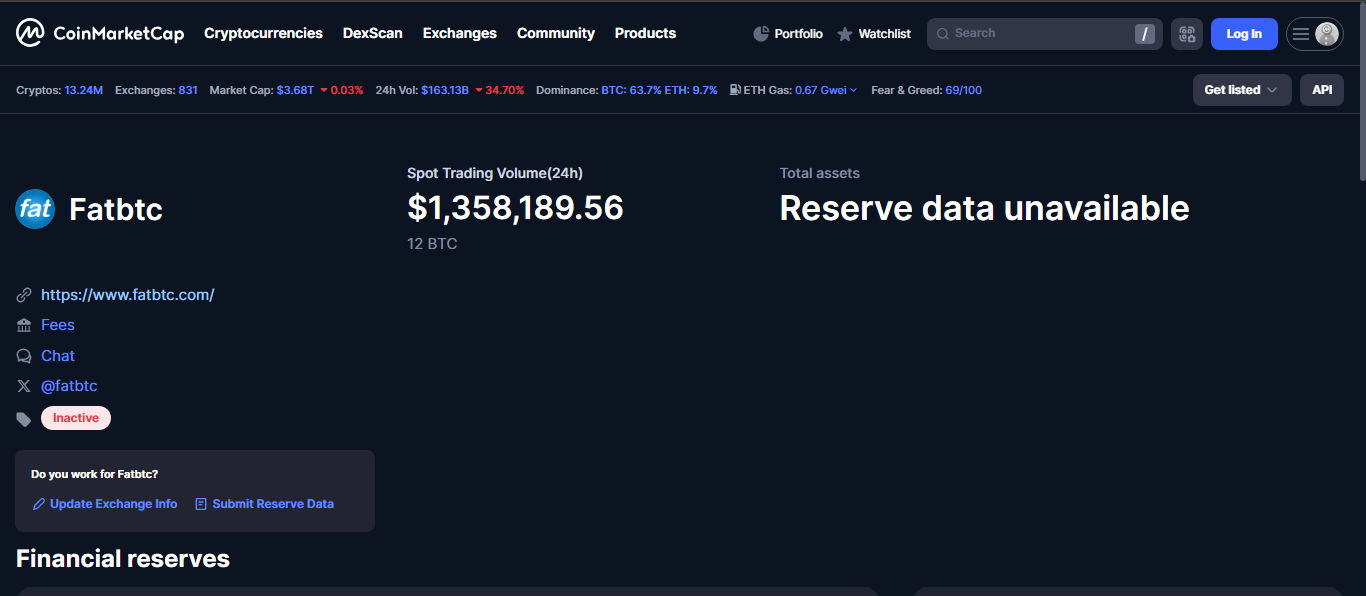FatBTC Review - A Cheap Exchange That Turned Into A Warning Sign

FatBTC came online in 2014 hoping to stand out with flat trading fees, a FAT token for discounts, and even demo accounts to lure new traders. Early on, some liked its beginner feel and the option to fund with wires in USD or EUR - rare for a loosely regulated exchange. But over the years the shine faded. Now the platform looks like a ghost town, its volumes gutted and its reputation shredded by countless complaints.
How it was supposed to work
FatBTC built itself around simplicity. It charged a flat 0.2 percent fee for all trades, no complicated tiers. Using FAT tokens could slash that to 0.1 percent. They added a demo account to practice without risk and ran small referral bonuses. For offshore users this seemed like a friendly place to get started.
They also advertised fiat deposits by bank wire, which is unusual for an exchange registered outside major regulatory zones. The interface stayed clean, and mobile apps made placing basic trades easy.
Where everything fell apart
At some point, probably around late 2024, the entire system stopped functioning. Trading activity dropped to nothing. FatBTC’s own pages often failed to load key markets, and external trackers listed daily BTC volumes at zero.
Then came the user stories. People reported deposits stuck in pending limbo, withdrawals left processing forever, and accounts frozen without cause. A few traders tried to complain, only to find there was no real support. Some said that after pushing back on delays, their profiles were locked entirely.
What users actually faced
- Withdrawals not processing at all, sometimes for years
- Trades matching at bizarre prices, making it impossible to sell fairly
- Accounts frozen after disputes, with no appeal or case system
- Claims that most order books were just bots pumping fake trades
Trust ratings for FatBTC sank fast. Customer scores on review platforms hovered around 1.9 out of 5, with frequent labels like scam, fraud and theft. In one story, a user had a small amount stuck for over two years, with no response from any staff. Another said they never saw meaningful volume - the books looked active but couldn’t fill even small orders.
A closer look at risk
The core problem is there’s no transparency. FatBTC never published audits, never provided proof of reserves, and stayed quiet about who actually runs the operation. Its safety grade on independent checks was dire, partly due to the total lack of security programs or bug bounties.
Terms of service even allowed them to freeze assets for vague reasons tied to “risk.” That means if they decided your account was suspicious, they could block it indefinitely with zero evidence.
No liquidity also means no real exit. Even if you placed an order, chances were it would sit there unfilled. Or worse, you’d fill against a bot at a ridiculous spread, then find yourself unable to withdraw.
What might still exist
You can technically open an account. The website is still live in parts. They list about 23 coins and around 30 trading pairs. But none show authentic depth. The fiat deposit option that once drew beginners likely doesn’t function anymore. Without meaningful volume, the whole market feels like empty shelves.
If anything does process, it would only be for tiny tests - and even that’s a massive gamble.
The final call on FatBTC
This is an exchange that’s collapsed in practice. It may still show a login page and a list of assets, but behind it is a dead engine. Funds disappear into pending queues. Orders don’t match like they should. And if you run into problems, there’s no clear team to contact or external body to step in.
Best for you if you’re just studying old offshore platforms for research or want to test a few cents to see how it breaks. Avoid it if you care at all about protecting your money, getting fair trades, or having the option to actually withdraw.
Bottom line
FatBTC is a textbook case of an offshore exchange that overpromised on low fees and bonuses, only to become a trap for user funds. If you stumble across it now, treat it purely as a cautionary tale. Keep your real capital far away. There are far better, safer exchanges for every kind of crypto user.
Disclaimer
“This content is for informational purposes only and does not constitute financial advice. Please do your own research before investing.”
.png)







%203.svg)
%203.svg)




















